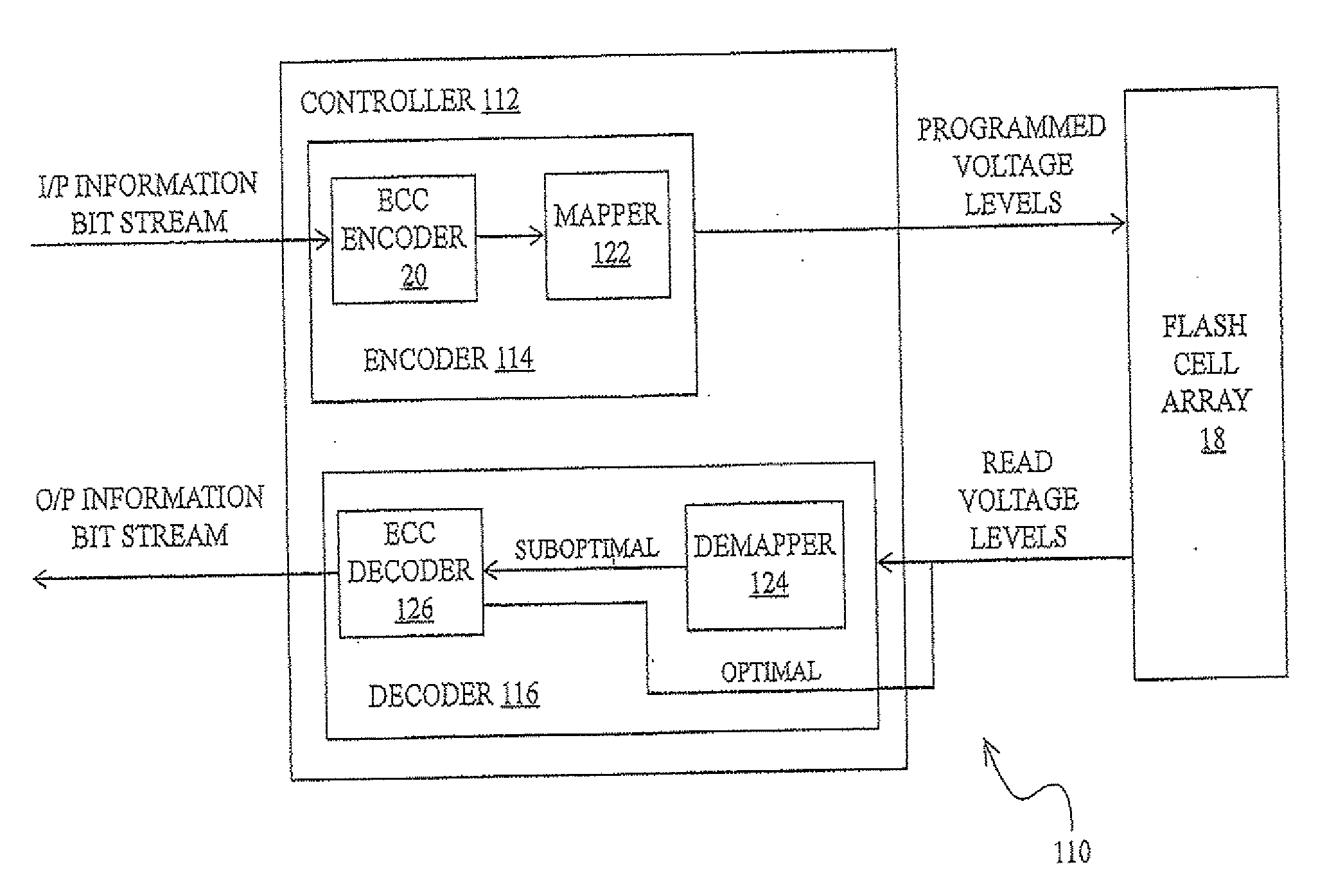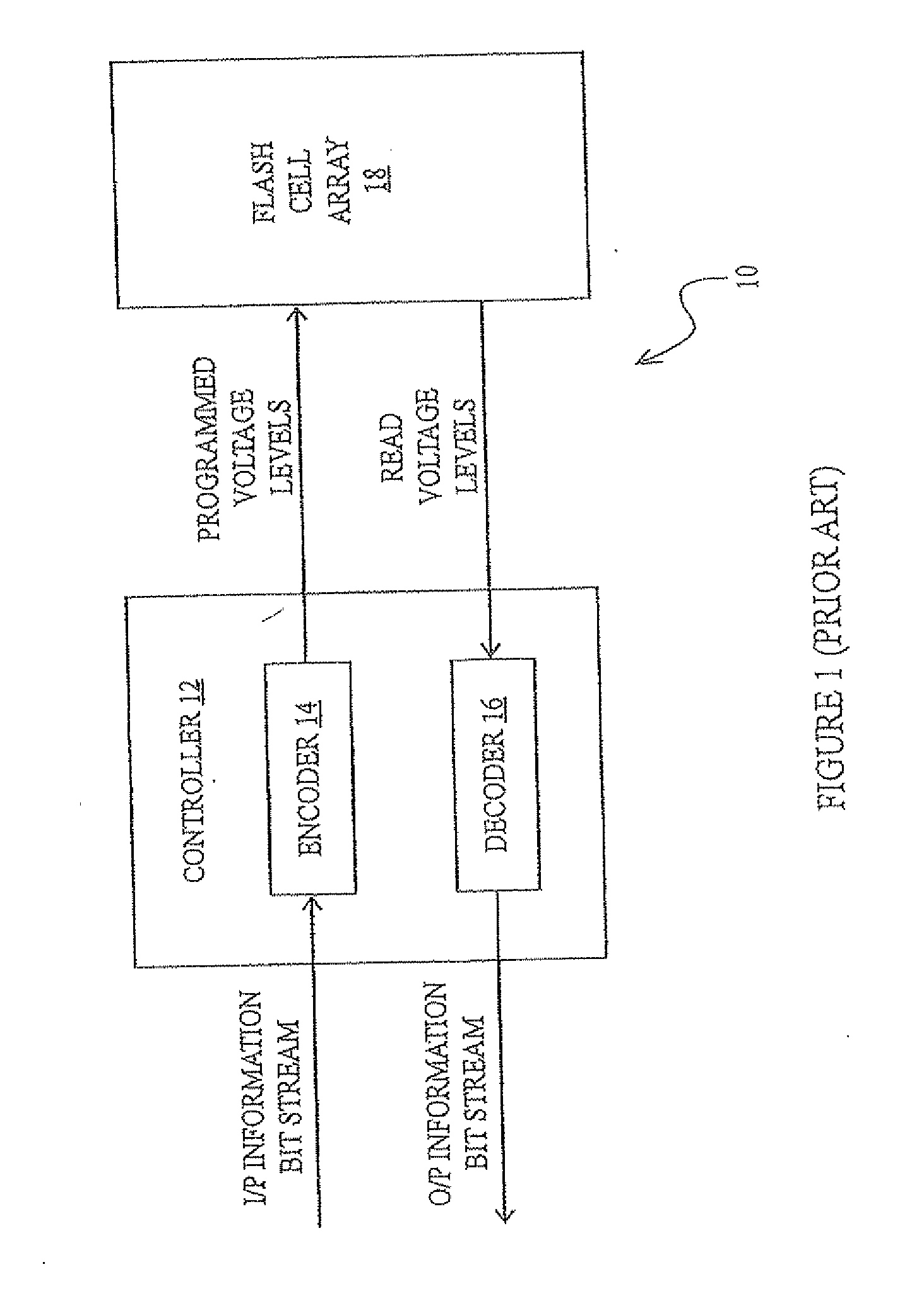Multi-bit-per-cell flash memory device with non-bijective mapping
a multi-bit per-cell, flash memory technology, applied in error detection/correction, digital storage, instruments, etc., can solve the problems of increasing the number of voltage levels, affecting the reliability of flash memory, and affecting the performance of flash memory,
- Summary
- Abstract
- Description
- Claims
- Application Information
AI Technical Summary
Problems solved by technology
Method used
Image
Examples
example 1
Computing the Capacity of Flash Memory 10 of FIG. 4
[0138]The programming and read voltage levels are: X=Y=[0 0.333 0.666 1] [Volts],
[0139]The flash memory suffers from an additive Gaussian noise with standard deviation σ=150 [mV],
[0140]Each programming level is programmed with equal probability:
[0141]P(Xi)=0.25 for i=1, 2, 3, 4
[0142]The transition probabilities are computed as follows:
P(YjXi)=Q(Yj-Xi-0.1667σ)-Q(Yj-Xi+0.1667σ)forj=2,3P(YjXi)=Q(Yj-Xi-0.1667σ)forj=1,4where,Q(x)=∫x∞12π-x2 / 2
[0143]Then the flash capacity is given by:
C=∑i=14∑j=14P(Xi)P(YjXi)log2(P(YjXi)∑k=14P(Xk)P(YjXk))=1.1612IBPC
example 2
Computing the Capacity of Flash Memory 110 of FIG. 5, Embodiment of Tables 4 and 5:
[0144]The programming and read voltage levels are: X=Y=[0 0.5 1] [Volts],
[0145]The flash memory suffers from an additive Gaussian noise with standard deviation σ=150 [mV],
[0146]The non-bijective mapping induces the following non-uniform distribution over the programming voltage levels:
[0147]P(X)=[0.375 0.25 0.375]
[0148]The transition probabilities are computed as follows:
P(YjXi)=Q(Yj-Xi-0.25σ)-Q(Yj-Xi+0.25σ)forj=2P(YjXi)=Q(Yj-Xi-0.25σ)forj=1,3
[0149]Then the flash capacity is given by:
C=∑i=14∑j=14P(Xi)P(YjXi)log2(P(YjXi)∑k=14P(Xk)P(YjXk))=1.2224IBPC
Annex B: Formal Function-Related Definitions
[0150]Definition (one-to-one): A function ƒ is said to be one-to-one (injective) if and only if ƒ(x)=ƒ(y) implies x=y. Otherwise, the function is many-to-one: there exists at least one argument pair (x,y) such that x≠y and ƒ(x)=ƒ(y).
[0151]Definition (onto): A function ƒ from a set A to a set B is said to be onto(su...
PUM
 Login to View More
Login to View More Abstract
Description
Claims
Application Information
 Login to View More
Login to View More - R&D
- Intellectual Property
- Life Sciences
- Materials
- Tech Scout
- Unparalleled Data Quality
- Higher Quality Content
- 60% Fewer Hallucinations
Browse by: Latest US Patents, China's latest patents, Technical Efficacy Thesaurus, Application Domain, Technology Topic, Popular Technical Reports.
© 2025 PatSnap. All rights reserved.Legal|Privacy policy|Modern Slavery Act Transparency Statement|Sitemap|About US| Contact US: help@patsnap.com



